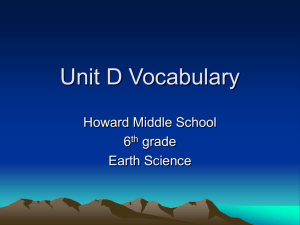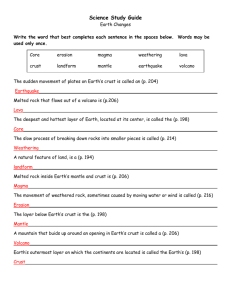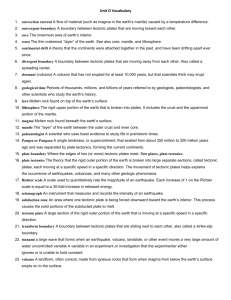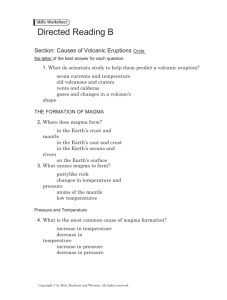Unit D Vocabulary - Bibb County Schools
advertisement
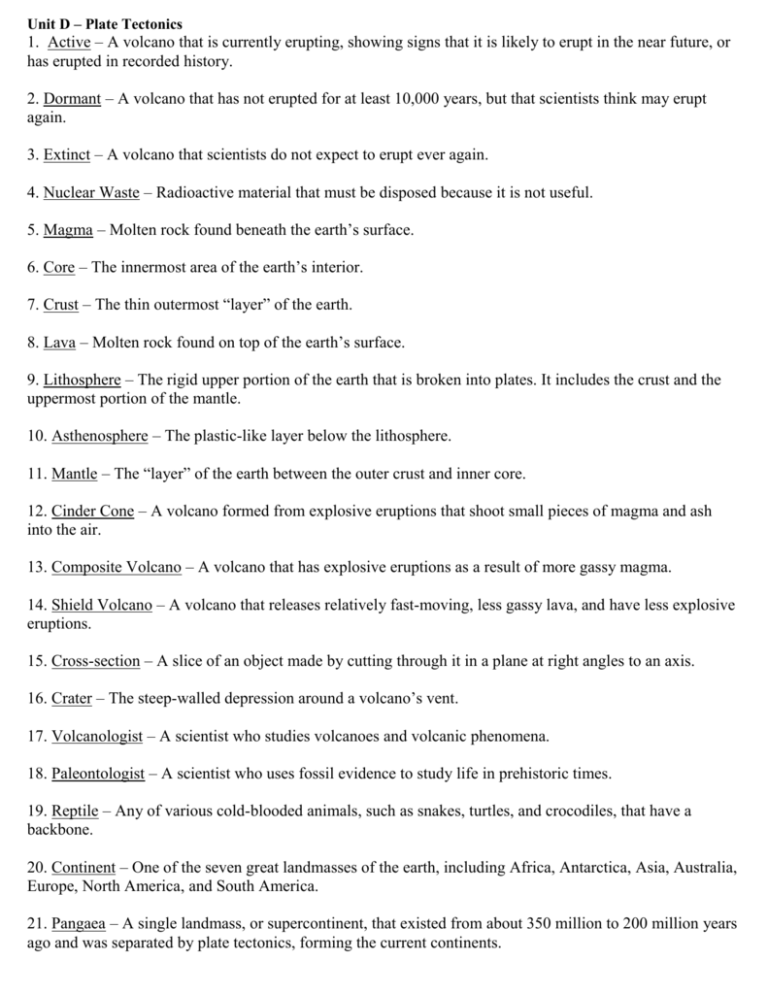
Unit D – Plate Tectonics 1. Active – A volcano that is currently erupting, showing signs that it is likely to erupt in the near future, or has erupted in recorded history. 2. Dormant – A volcano that has not erupted for at least 10,000 years, but that scientists think may erupt again. 3. Extinct – A volcano that scientists do not expect to erupt ever again. 4. Nuclear Waste – Radioactive material that must be disposed because it is not useful. 5. Magma – Molten rock found beneath the earth’s surface. 6. Core – The innermost area of the earth’s interior. 7. Crust – The thin outermost “layer” of the earth. 8. Lava – Molten rock found on top of the earth’s surface. 9. Lithosphere – The rigid upper portion of the earth that is broken into plates. It includes the crust and the uppermost portion of the mantle. 10. Asthenosphere – The plastic-like layer below the lithosphere. 11. Mantle – The “layer” of the earth between the outer crust and inner core. 12. Cinder Cone – A volcano formed from explosive eruptions that shoot small pieces of magma and ash into the air. 13. Composite Volcano – A volcano that has explosive eruptions as a result of more gassy magma. 14. Shield Volcano – A volcano that releases relatively fast-moving, less gassy lava, and have less explosive eruptions. 15. Cross-section – A slice of an object made by cutting through it in a plane at right angles to an axis. 16. Crater – The steep-walled depression around a volcano’s vent. 17. Volcanologist – A scientist who studies volcanoes and volcanic phenomena. 18. Paleontologist – A scientist who uses fossil evidence to study life in prehistoric times. 19. Reptile – Any of various cold-blooded animals, such as snakes, turtles, and crocodiles, that have a backbone. 20. Continent – One of the seven great landmasses of the earth, including Africa, Antarctica, Asia, Australia, Europe, North America, and South America. 21. Pangaea – A single landmass, or supercontinent, that existed from about 350 million to 200 million years ago and was separated by plate tectonics, forming the current continents. 22. Theory – A logically consistent explanation of some aspect of the natural world that is supported by a large body of evidence. 23. Continental Drift – A theory that the continents were attached together in the past, and have been drifting apart ever since. 24. Plates – Large sections of the earth’s surface. 25. Plate Tectonics – The theory that the rigid outer portion of the earth is broken into large separate sections, called tectonic plates, each moving at a specific speed in a specific direction. 26. Seafloor Spreading – Harry Hess’s theory that new seafloor is formed when magma is forced upward toward the surface at a mid-ocean ridge. 27. Convection Current – A flow of material (such as magma in the earth’s mantle) caused by a temperature difference. 28. Convergent – A boundary between tectonic plates that are moving toward each other. 29. Divergent – A boundary between tectonic plates that are moving away from each other. 30. Transform – A boundary between tectonic plates that are sliding next to each other. 31. Earthquake – The release of energy in the form of waves that occurs when large masses of rock below earth’s surface suddenly shift position. 32. Fault – A crack in a rock mass along which there has been movement caused by the shifting of the earth’s crust. 33. Focus – In an earthquake, the point below Earth’s surface where energy is released in the form of seismic waves. 34. Epicenter – The point on Earth’s surface directly above the earthquake focus. 35. Richter Scale – A scale used to quantitatively rate the magnitude of an earthquake. 36. Hot Spot – A place on earth’s surface that is directly above a column of rising magma called a mantle plume. 37. Seismogram – The information recorded by a seismograph. 38. Seismograph – An instrument that measures and records the intensity of an earthquake. 39. Subduction – An area where one tectonic plate is being forced downward toward the earth’s interior. 40. Risk – The chance that a particular action or event could result in something unfavorable, such as injury or death.
